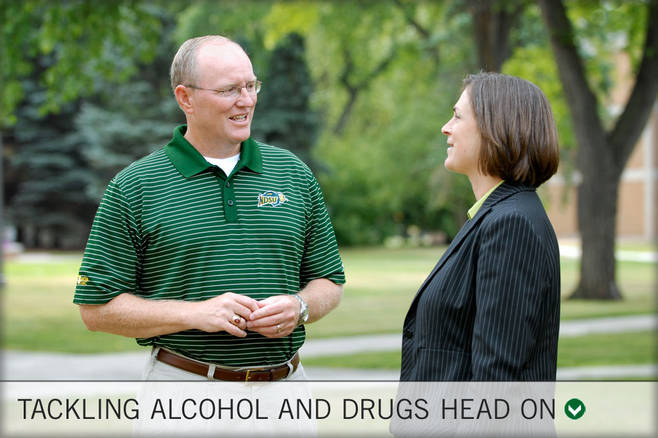
He's the only athletic director in the country who heads up a drug and alcohol prevention task force. She brings a lifelong commitment to fighting substance abuse. Gene Taylor, NDSU athletic director, and Laura Oster-Aaland, director of orientation and student success, led a two-year-long process that resulted in a comprehensive, long-term plan to reduce alcohol and other drug abuse by students.
The Strategic Plan to Address High Risk Alcohol and Other Drug Use takes an environmental management approach to prevention by addressing the problem from many angles. NDSU is a dry campus and has long had prevention strategies in place. The goal of the new plan is to enhance existing policies in order to create an environment for intellectual and personal development by promoting safety and welfare for all members of the university community.
This plan is a critically important piece in a process that is aimed at decreasing the high risk use of alcohol by our students which will ultimately lead to a reduction of the problems associated with high risk alcohol use and increase the success of our students in the classroom.
In a recent study released by the United States Health and Human Services Department, North Dakota leads the country in binge drinking. More than 40% of people ages 12 - 20 have had at least one drink during the month the survey was done.
The state statistics make our job particularly difficult. Our students are influenced by what they see, and unfortunately, what they see is high risk drinking among all age groups -- adults included. That's why it is essential that we involve the community in prevention efforts. Everyone has a role to play, Aaland said.
The plan comes after two years of work by the President's Council on Alcohol and Other Drugs, which includes a mix of faculty, staff and students. President Joseph A. Chapman charged the council with creating a strategic plan that included accountability at all levels, was far reaching in its scope, included measurable outcomes and reflected the core values of the university. The plan's aim is not to eliminate the use of alcohol, but rather to reduce the high-risk use that leads to problems for individuals and the community. The actions outlined in the plan are based on proven prevention strategies.
"We have two choices. Do nothing or do something. Where will we be in 10 years if we do nothing? It is simply not an option. It is our responsibility as an institution of higher education to do everything we can to help our students succeed in life. And the decisions they make now about drugs and alcohol affects their lives long after they leave here, Chapman said.
A few of the actions outlined in the plan include piloting online personalized alcohol education for all incoming first-year students, providing consistent late-night weekend events for students on campus and implementing a nationally recognized counseling program for students at high risk for alcohol related problems.
There are several other universities that have had success with the programs we are going to be implementing. We are using strategies that have research to back them up, said Aaland.
The plan also addresses athletics. In addition to already existing programs, two new programs will be implemented. MyPlaybook is an internet-based substance-abuse prevention program specifically for student athletes. BASICS is a pilot program for students at high-risk for alcohol related problems.
Changing how students think about using drugs and alcohol is not going to happen overnight. This is going to take a long time. It�s a marathon, not a sprint, said Taylor.